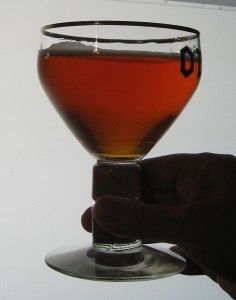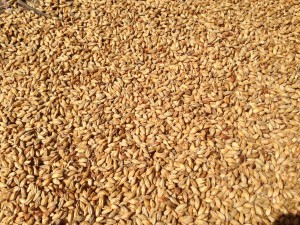
Barleywines are big, full-bodied beers. (This beer was a pale ale, but the color looks about right for a barleywine.)
Barleywines are full-bodied beers. Unlike double IPAs, which are also big, hoppy ales, the final gravity of a barleywine is usually in the 20s, when going by “gravity points” (SG 1.020–1.029). Sometimes it creeps up into the low 30s and others it drops into the high 10s. (The BJCP gives FG 1.018–1.030 for English barleywines and 1.016–1.030 for 1.016–1.030 for American barleywines.) For double IPAs, the brewer must make an effort to get the beer to finish under 1.020, or the hop character may be obscured.
Attenuation and Finishing in the 20s
When brewing a normal-strength beer, you would have to do a variety of things to get a beer to finish as high as a barleywine. For example, doing a short, single-infusion mash in the range of 156–162 °F (69–72 °C) would contribute to a higher than usual final gravity (FG). Adding a relatively large amount of caramel or dextrin malt (such as CaraPils) or adding maltodextrin (or other unfermentable carbohydrates) in the boil would also increase the final gravity. And finally, selecting a yeast strain with a low degree at attenuation, and perhaps slightly underpitching, would also contribute to a higher FG.
In a barleywine, however, you don’t need to do any of these things. The beer will finish at a reasonably high FG simply because its OG is so high. Formulating the beer and tweaking your procedures to make wort with a middle-of-the-road, or even fairly high, degree of fermentability will result in an acceptable FG. Likewise, you can choose a moderately attenuative to highly attenuative yeast strain and still not make a barleywine that is too dry. Because of the high OG, you should never attempt to raise the FG by under pitching — always pitch a near-optimal amount of yeast. Even under the best conditions, they have a lot of work to do in a barleywine.
A Starting Point for Recipe Formulation
As we saw in the article on color, most of the color in a barleywine wort comes straight from the malt. It may pick up a small amount of color from a long boil (due to melanoidin production via Maillard reactions), but the amber or darker color basically comes from the large amount of malt in the grist. Even if the grist is 100% 2-row pale ale malt (~3 °L), an OG 1.080 barleywine will still end up in the golden to light amber range due to the amount of malt and the slight amount of color pickup in the boil. In addition, as I mentioned in the section on attenuation, the final gravity of the beer will likely fall into the right range without a lot of help from specialty malts in the grist. In fact, a wort made from 100% 2-row pale malt, mashed at around 150–152 °F (66–67 °C) and pitched with an adequate amount of yeast cells from a moderately attenuative ale strain (75% apparent attenuation), would likely finish at FG 1.020 or above if the original gravity (OG) was above 1.080.
Recipe Design (Malts)
So, one way to look at recipe design for a barleywine is to realize that, if you add enough malt to hit the minimum OG (1.080), the pale malt alone will get you close to or into the lower range for color and FG. All you need to do is decide how much stronger you want the beer, and the added color and flavors you want from your specialty malts.
Most barleywines are formulated essentially as a very big pale ale. The grist is usually 2-row pale malt (~2 °L) or pale ale malt (~3 °L), plus a bit of medium crystal malt (often 30–60 °L, and sometimes smaller amounts of a darker crystal malt). Some Munich malt may be added for added malt character and very small amounts of other specialty malts may be added to tweak the color or flavor. Dextrine malts (such as CaraPils) aren’t really needed. Likewise, kettle adjuncts also should be avoided — barley wines are almost always all-malt beers. (There are exceptions among the English barleywines.)
You do not need a fancy or complex recipe to make a great barley wine; the success or failure of your beer is going to depend mostly on how you conduct the fermentation (a topic I”ll cover later).
For an American barleywine, pale malt plus a little crystal malt (30–60 °L) is a perfectly good recipe. Keep the amount of crystal malt at or below the amount your would use in a pale ale — for 5.0 gallons (19 L), use under a pound (450 g). Substituting about 10% of the pale malt for Munich malt is also an option, but your beer will already be malty from the large amount of pale malt. Some versions of American barleywines tend towards the low end of the color and FG range. For these, keep the amount of anything other than the pale malt low. See the recipe for Hero Barleywine as an example of a American barleywine.
For an English barleywine, pale ale malt, a bit of crystal malt (40–60 °L) and maybe a small amount of darker crystal malt or a tiny amount of chocolate malt is a good recipe. Keep the amount of crystal malt in the range of a regular English pale ale — again, under a pound (450 g)— and use only enough of the darker malts to tweak the color. Swapping some Munich for about 10% of the pale malt is also an option. Tomorrow, I’ll post an example of an English barleywine.
As with pale ales, there are a lot of common variants among commercial and homebrewed barleywines. Some use a bit of wheat malt; some use small amounts of dark malts for color; some use small amounts of biscuit or other specialty malts (aromatic malt, small amounts of smoked malt) for added flavor. Bigger barleywines may use a small amount (usually less than 10%) of sugar in the boil to boost the OG but not let the FG climb too high. Among English barleywines, a little brown sugar is not unheard of. You could also experiment with small amounts of rye. Feel free to experiment, but also know that a barleywine from a very straightforward recipe can be fantastic.
What to Do With All the Malt
Once you’ve got your recipe assembled, there are a variety of approaches you can take for wort production. In some cases, you may need to come back and alter your recipe to account for your techniques. I’ll discuss that later in an article on wort production.
—
Related articles
American Hoppy Ales (Malts and the Grain Bill)
Fermentability in Extract Worts


Speak Your Mind